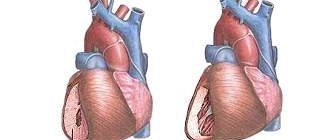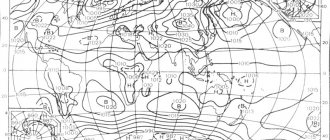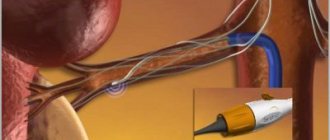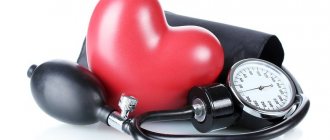Both indicators are used to assess the level of upper and lower pressure. They change up or down due to certain factors of pathological or physiological origin. Experienced doctors can almost always correctly identify developing cardiovascular diseases based on blood pressure abnormalities.
Regulatory data
The level of blood pressure, diastolic and systolic, is influenced by:
- general condition of the body's blood vessels;
- gender;
- patient's age;
- stressful situations;
- overwork;
- physical exercise;
- a certain way of life.
The difference between the two is related to the physiological processes taking place in the human body. Contraction of the heart muscle provokes a blood discharge that affects the left ventricle. Subsequently, as the blood moves through the arteries, capillaries and veins, the blood pressure level gradually decreases. As the flow returns back to the heart, it will be minimal.
Table of normal indicators:
| Blood pressure in mm | Diastole in mm | Systole in mm |
| Norm | 80 | 120 |
| Valid values | 81-85 | 121-130 |
| Excess | 86-89 | 131-140 |
| Hypertension 1 st. | 90-100 | 141-160 |
| Hypertension 2 tbsp. | 101-110 | 161-180 |
| Complex hypertension | over 110 | above 180 |
Importance of indicators
So is it possible to conclude which of these indicators is more important? “As we have already figured out, each of these parameters has its own meaning, so they are both important. Currently, it is also customary to distinguish between isolated systolic hypertension, when only the upper pressure is increased, and isolated diastolic hypertension when only the lower pressure is increased. Each of these forms has its own prognostic significance and some features in treatment, so it is necessary to approach the identification and correction of these types of hypertension with equal attention,” notes Maria Benevskaya.
What does diastole and systole show?
Diastolic pressure refers to the lower limits of blood pressure, showing the level of blood pressure when the heart muscle is relaxed, the resistance force of blood vessels located on the periphery.
In a normal state, diastole is 80 mmHg. A drop in this figure occurs as a consequence of the reducing effect during the passage of blood flow through the venous, arterial, and capillary lines.
Systolic pressure is the maximum indicator of blood pressure, recorded when the heart contracts and sends blood flow through the vessels. Systole is the upper value, which in a healthy body (without cardiovascular pathologies) is equal to 120 mmHg.
In a person without hidden or obvious diseases, systolic blood pressure changes under the influence of individual triggers:
- strength of heart contractions;
- the level of elasticity of veins, arteries and capillaries, their tone;
- physical activity;
- stress, emotional turmoil.
An increase in systole indicates hidden or obvious pathological processes in the heart and blood vessels. Deviations require a full laboratory diagnostic examination and a competent approach to subsequent therapy.
Causes of high blood pressure
When measuring pressure, the state of blood flow is assessed - how correctly the blood circulates through the vessels. Hypertension occurs when circulation is impaired and more force from the heart is required to push blood through the vascular bed. This can happen for several reasons:
- Increased blood volume. In this case, the blood puts more pressure on the vessels. Normally, to compensate for excess fluid, the walls of blood vessels stretch, and the pressure normalizes. But, when tissue elasticity is lost, stretching does not occur or is insufficient. Typically, blood volume increases with increased salt intake.
- Narrowing of the lumen of blood vessels. The cross-section of the vessel becomes smaller, making it difficult for the fluid to pass through. In the short term, this condition develops against the background of stress, physical activity, and a sharp drop in temperature. These are reversible reactions. A common cause of constant narrowing of the lumen is atherosclerosis - the deposition of cholesterol plaques.
- Increased blood viscosity. This condition is caused by dehydration, diseases of the immune system, metabolic disorders, obesity, varicose veins, dietary errors, alcohol consumption and other factors. To ensure that thicker blood circulates, high pressure must be created.
A systemic increase in blood pressure indicates chronic pathology. In addition to normalizing blood pressure, it is necessary to diagnose the cause and carry out complex therapy.
Features of pulse pressure
The term refers to the difference between systole and diastole. It shows the patency of blood vessels and the general condition of their internal membranes. The ideal difference between the two values should be 60 mmHg; a larger gap in the data indicates vascular spasm or inflammatory processes occurring in the blood vessels.
A greatly reduced level of pulse blood pressure is considered characteristic of certain pathologies, represented by:
- heart failure;
- stroke in the left ventricle of the heart;
- myocardial infarction.
If deviations from standard sizes within 40-55 units are detected, you must consult a cardiologist. The doctor will issue a referral for a laboratory diagnostic examination, and after clarifying the presumptive diagnosis, he will prescribe therapy in accordance with the detected disease.
Attention to the gap
Of course, as experts note, it is also necessary to look at the gap between these parameters. “I repeat that the normal difference between upper and lower pressure is from 30 to 50 mm Hg. Art. All values that do not fit within these limits may indicate the presence of pathology, and this is already a reason to undergo additional examination. Although at the same time this may be due to the individual characteristics of the body and physiological conditions. But in any case, it’s better to see a doctor so as not to miss the disease,” notes Maria Benevskaya.
So, for example, the specialist emphasizes, a small difference may indicate:
- the presence of atherosclerosis of the aorta (deposition of cholesterol in the largest vessel);
- damage to the kidney vessels;
- aortic aneurysm (pathological expansion of a separate section of the aorta with the possibility of rupture or dissection of the walls due to excessive load);
- anemia (decreased hemoglobin levels in the blood) and many other conditions.
“An increase in the difference may be a consequence of osteochondrosis of the cervical spine, aggravated by a malnutrition of the brain (most often vertebrobasilar insufficiency). Diseases of the musculoskeletal system lead to weakening of cerebral blood flow. Hence the problems with upper and lower pressure in general,” notes the cardiologist.
Also, as Maria Benevskaya says, various endocrine diseases can lead to changes in pulse pressure. And this is not the entire range of pathologies that affect this parameter. A change in this indicator can be a “bell” to pay attention to your health.
Hot towel and vinegar. What folk remedies quickly reduce blood pressure? More details
What is the importance of diastolic blood pressure
Diastole refers to an indicator that includes two important factors:
- The first one determines the tension or relaxation of the capillary line. With strong compression, the diastole will be higher, which indicates a malfunction occurring in the cardiovascular department, a high risk of hypertensive syndrome. When the level is reversed, a drop in diastolic blood pressure is observed.
- The second indicates the degree of relaxation of the heart muscle during diastole. If the data is bad, the issue is related to the lack of normal rest and the heart working hard. Regular overloads over time provoke various pathological changes against the background of wear and tear.
Recorded changes should not be ignored. A timely visit to the clinic will allow you to catch the disease in the early stages, avoiding its severe course and many complications.
How to measure blood pressure correctly?
To obtain reliable blood pressure readings, you need to take measurements in a quiet environment at room temperature. For about an hour, it is not advisable to smoke or drink strong coffee or tea. For half an hour you need to eliminate physical activity. Your feet should be on the floor and your hands should rest freely at heart level.
There are a few more simple rules:
- During the measurement, you cannot move, talk or cross your legs;
- The cuff should fit snugly on the arm, but not squeeze it;
- If several measurements are required, at least 5 minutes must elapse between them;
- The cuff is selected so that it covers at least 80% of the shoulder circumference. If you have to hold the Velcro with your hand, the results will be incorrect;
- In the absence of back support, the indicators may be overestimated.
Doctors often refer to the so-called “working pressure”. The fact is that, depending on the state of the body and its individual characteristics, the interval of the upper and lower indicators may differ for different people. Working blood pressure is the blood pressure at which a person remains in good health. This could be, for example, 130/90 or 115/80.
There is only one way to determine your working pressure: measure it regularly. Then you can find out what values the tonometer shows when a person feels well. This is an important nuance, since with a reduced operating pressure the same 130/90 can be considered as a significant increase, although the numbers themselves are within the norm.
Why you need to contact a specialist
When treating hypertensive syndrome, it is important to understand exactly what factor influenced the poor diastolic pressure readings. For vascular spasm, certain drugs are prescribed, and for insufficient relaxation of the heart, completely different ones are prescribed.
Important:
On his own, the patient cannot understand what exactly the problem is: the blood vessels are strongly compressed or the heart muscle is poorly relaxed. It is important to consult a doctor and find out the causes of the disease.
With low blood pressure, the supply of oxygen to all systems of the body deteriorates, and oxygen starvation, brain and other disorders can develop. High blood pressure threatens stroke, heart attack, blindness, kidney failure and other terrible consequences.
Non-parallel increase or decrease of two indicators
Situations with pressure are different, it is not at all necessary that there is a parallel increase or decrease in both indicators. In this regard, we will consider some options that are especially puzzling for patients:
- The upper pressure is high, and the lower is low, or systolic is elevated, and the lower is normal
- a similar phenomenon is observed in cases of isolated systolic arterial hypertension, which can be primary and secondary. Primary hypertension is caused by age-related changes in blood vessels and often develops in older people. However, such pathological conditions as severe aortic insufficiency, arteriovenous fistulas, severe forms of anemia and kidney damage are a prerequisite for the formation of secondary isolated hypertension and at the same time the causes of low lower pressure. Obviously, it is unlikely that the patient himself will be able to raise such low blood pressure (just like lowering high blood pressure), since in such cases, first of all, you need to start with the treatment of the underlying disease, for which blood pressure fluctuations are just a symptom. - Arterial hypertension without a characteristic appearance,
often falling under the purview of a nephrologist (renovascular and renoparenchymal hypertension), is distinguished by a small difference between systolic and diastolic pressure, mainly due to an increase in the latter, that is, the presence of renal pathology does not mean that only the lower pressure will increase. Systolic will also creep up, but with some delay. This variant of hypertension refers to symptomatic (nephrogenic) arterial hypertension.
Renal hypertension probably has the largest share among all hypertension of this kind. In addition to it, among the symptomatic forms one can find neurogenic, endocrine, iatrogenic, hemodynamic and other arterial hypertension.
When is increased blood pressure considered normal?
High blood pressure is not necessarily a sign of illness. Its short-term increase is also possible for physiological reasons
:
- 1
Childhood and adolescence. In children, the cardiovascular system develops more slowly than the musculoskeletal system, and in adolescence the body experiences hormonal changes. It is accompanied by changes in mood for no apparent reason, which leads to jumps blood pressure.At rest, a teenager’s indicators may be higher than during physical activity.
- 2
Physical exercise. Running, lifting weights and other types of physical activity increase the oxygen demand of the involved muscle groups. This need, due to increased frequency and strengthening of heart contractions, is ensured by intense blood flow. Due to the accelerated work of the cardiovascular system, an increase in pressureduring and after physical activity.
- 3
Stress. Situations in which a person experiences anger or fear lead to the release of adrenaline into the blood. The result is tachycardia and high blood pressure.
Normal pressure
increases briefly.
This is not a cause
for concern, but a reason to monitor to rule out the development
of hypertension
.
What is a person's lower blood pressure responsible for?
The blood ejected during systole quickly passes through the arteries, reaching small capillaries and vessels. The walls of these vessels, contracting, resist the incoming blood flow, and the greater this resistance, the higher the diastolic blood pressure. Therefore, a person’s lower pressure is responsible for the degree of resistance of blood vessels to blood flow. The higher it is, the worse the permeability of the vessels, the greater the resistance they provide to the blood. Conversely, the lower the resistance, the lower the diastolic readings.
Treatment of low diastolic pressure
Since diastolic hypotension can be caused by a variety of reasons, methods of treating low diastolic pressure consist of: examining the patient, studying his medical history for chronic diseases and allergies to medications, as well as the form of hypotension observed at the moment (it can be acute or chronic in remission ). If the patient has an acute form of hypotension, then the following medications are used:
- Drugs that improve blood supply to the brain and increase pulse blood pressure;
- Medicines that increase vascular tone and help improve blood supply to the body, such as Angiotensinamide. During a hypotensive crisis, it is injected into a vein using a dropper.
- If the patient has demonstrated positive dynamics, and there has been stable improvement in his condition, then doctors prescribe drugs with tonic, immuno- and neurostimulating effects.









